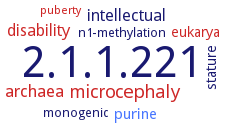2.1.1.221: tRNA (guanine9-N1)-methyltransferase
This is an abbreviated version!
For detailed information about tRNA (guanine9-N1)-methyltransferase, go to the full flat file.

Word Map on EC 2.1.1.221 
-
2.1.1.221
-
microcephaly
-
archaea
-
disability
-
intellectual
-
purine
-
stature
-
eukarya
-
n1-methylation
-
monogenic
-
puberty
- 2.1.1.221
- microcephaly
- archaea
- disability
-
intellectual
- purine
-
stature
- eukarya
-
n1-methylation
-
monogenic
- puberty
Reaction
Synonyms
EC 2.1.1.31, hTRMT10A, m1G9 methyltransferase, m1G9 MTase, m1R9-specific TkTrm10, More, ScTrm10, SPOUT MTase, TK0422p, TkTrm10, Trm10, Trm10p (ambiguous), TRMT10A, Trmt10C, tRNA (guanine-N(1)-)-methyltransferase, tRNA m1G9 methyltransferase, tRNA m1G9 MTase, tRNA m1G9 SPOUT methyltransferase, tRNA m1R9 methyltransferase, tRNA(m1G9/m1A9)-methyltransferase, tRNA(m1G9/m1A9)MTase
ECTree
Advanced search results
Engineering
Engineering on EC 2.1.1.221 - tRNA (guanine9-N1)-methyltransferase
Please wait a moment until all data is loaded. This message will disappear when all data is loaded.
D210N
site-directed mutagenesis, the mutant is resistant to 5-fluorouracil similarly to the wild-type enzyme
G206R
site-directed mutagenesis, inactive variant of hTRMT10A with abolished methylation activity, likely due to an inability to bind cofactor SAM
R127stop
naturally occuring nonsene mutation involved in the syndrome of young onset diabetes
D210A
site-directed mutagenesis, the mutant does not abolish the mutant enzyme's activity, but modestly decreases it
D210K
site-directed mutagenesis, the mutant does not abolish the mutant enzyme's activity, but modestly decreases it
D210N
N212A
site-directed mutagenesis, the mutant shows increased Km for tRNA compared to the wild-type
D210A
-
site-directed mutagenesis, the mutant does not abolish the mutant enzyme's activity, but modestly decreases it
-
D210K
-
site-directed mutagenesis, the mutant does not abolish the mutant enzyme's activity, but modestly decreases it
-
D210N
-
site-directed mutagenesis, the mutant does not abolish the mutant enzyme's activity, but modestly decreases it
-
K110E/R121E/R127E
site-directed mutagenesis, inactive mutant
K208A
site-directed mutagenesis, mutation of a nucleoside binding pocket residue, the mutant shows 28% reduced activity compared to the wild-type enzyme
N209A
site-directed mutagenesis, the mutant shows increased Km for tRNA compared to the wild-type
Q118A
site-directed mutagenesis, mutation of a nucleoside binding pocket residue, inactive mutant
T244A
site-directed mutagenesis, mutation of a nucleoside binding pocket residue, the mutant shows 65% reduced activity compared to the wild-type enzyme
V206A
site-directed mutagenesis, mutation of a nucleoside binding pocket residue, the mutant shows 81% reduced activity compared to the wild-type enzyme
K208A
-
site-directed mutagenesis, mutation of a nucleoside binding pocket residue, the mutant shows 28% reduced activity compared to the wild-type enzyme
-
N209A
-
site-directed mutagenesis, the mutant shows increased Km for tRNA compared to the wild-type
-
Q118A
-
site-directed mutagenesis, mutation of a nucleoside binding pocket residue, inactive mutant
-
T244A
-
site-directed mutagenesis, mutation of a nucleoside binding pocket residue, the mutant shows 65% reduced activity compared to the wild-type enzyme
-
D104A
site-directed mutagenesis, the mutant shows highly reduced activity compared to wild-type
D104A/E115Q/D245A
site-directed mutagenesis, almost inactive mutant
D104N
site-directed mutagenesis, the mutant shows slightly increased activity compared to wild-type
D104N/D206N/D245N
site-directed mutagenesis, the mutant shows highly reduced activity compared to wild-type
D104N/D206N/D245N/E115Q
site-directed mutagenesis, the mutant shows highly reduced activity compared to wild-type
D206A
site-directed mutagenesis, the enzyme activity is modestly reduced compared to wild-type
D206A/D245A
site-directed mutagenesis, the enzyme activity is abolished in the double mutant
D206N
site-directed mutagenesis, the mutant shows moderately reduced activity compared to wild-type
D245A
site-directed mutagenesis, the enzyme activity is modestly reduced compared to wild-type
D245N
site-directed mutagenesis, the mutation has no significant effect on the A-preference for TktRNAAsp, but exhibits a modest, but shows about 4fold reduced G-preference activity compared to wild-type
E115Q
site-directed mutagenesis, the mutant shows moderately reduced activity compared to wild-type
G202R
site-directed mutagenesis, the mutant is nearly inactive, nearly complete loss of both m1G9 and m1A9 activity
G242R
site-directed mutagenesis, the mutant shows unaltered activity
Q122A
site-directed mutagenesis, the mutant shows highly reduced activity compared to wild-type
D104A
-
site-directed mutagenesis, the mutant shows highly reduced activity compared to wild-type
-
D104N
-
site-directed mutagenesis, the mutant shows slightly increased activity compared to wild-type
-
D206A
-
site-directed mutagenesis, the enzyme activity is modestly reduced compared to wild-type
-
D206N
-
site-directed mutagenesis, the mutant shows moderately reduced activity compared to wild-type
-
E115Q
-
site-directed mutagenesis, the mutant shows moderately reduced activity compared to wild-type
-
additional information
5-fluorouracil (5FU) hypersensitive phenotype of trm10 deletion in Saccharomyces cerevisiae. Growth of the trm10DELTA strain is inhibited compared to a TRM10 wild-type strain in media containing 0.001 mg/ml 5FU. This growth defect is due to the loss of TRM10, since expression of a wild-type copy of either ScTrm10 or hTRMT10A complements this phenotype at either 30 °C or 37°C, while expression of the empty vector does not restore wild-type growth to the trm10DELTA strain. Cells expressing the hTRMT10A D210N variant are similarly resistant to the effects of 5FU as either wild-type enzyme, consistent with the in vitro biochemical results
D210N
site-directed mutagenesis, the mutant does not abolish the mutant enzyme's activity, but modestly decreases it


 results (
results ( results (
results ( top
top






